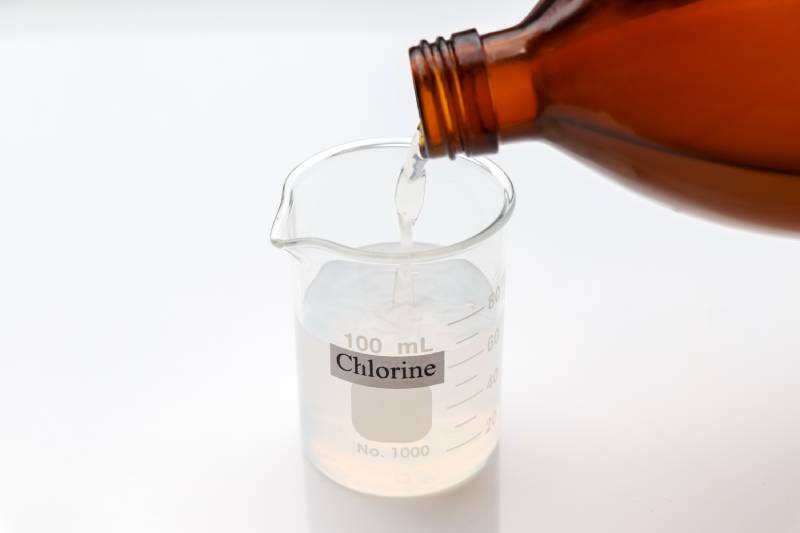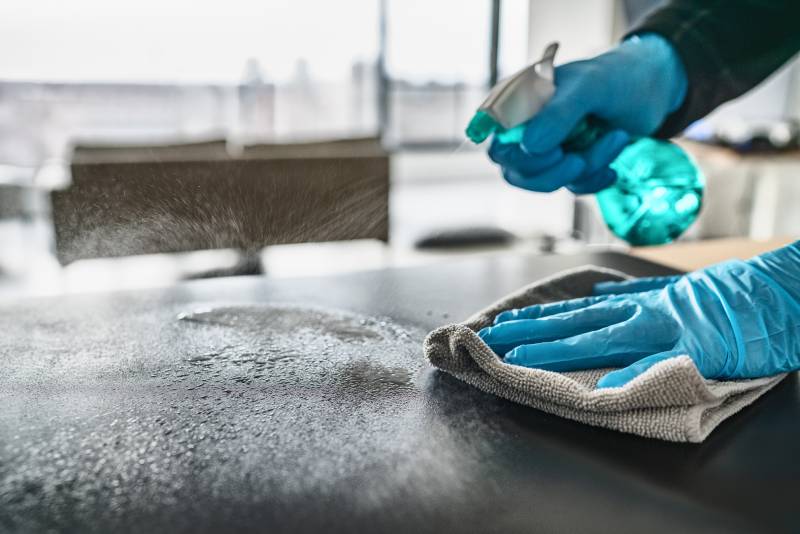- October 16, 2023
Does Chlorine Kill Fleas? Vet Reviewed Effectiveness & Safety Tips



The information is current and up-to-date in accordance with the latest veterinarian research.
Fleas are one of the potential downsides to owning a pet. These tiny bloodsuckers show up on your beloved animal, and then you start finding them everywhere—bedding, carpet, yourself. By then, it isn’t just your pet that’s miserable; you are too! But killing fleas can be challenging at times; small as they are, fleas are tenacious. The good news is that there are plenty of flea control products on the market.
But the bad news is only some of them are safe and effective.
So, you might consider taking an easier approach to ridding your home of fleas rather than trying a number of flea control products. But what works best? Does chlorine kill fleas? The answer is yes, chlorine can kill fleas, but it’s not an option we would recommend.

Chlorine & Pets
The first thing to know about killing fleas is that you need to kill fleas at every life cycle stage. What does that mean? It means that if you only kill the adults, there will be eggs hatching and larvae developing to take their place. Similarly, if you only kill the eggs, there will still be adults around to reproduce. So if you want to get rid of fleas, you need to stop the reproductive cycle too.
Chlorine is a disinfectant found in everything from bleach to the water in swimming pools. While it can certainly kill adult fleas and eggs when used at specific concentrations, it won’t completely eradicate flea larvae and pupa. Where chlorine can come in handy is when you’re trying to treat countertops or other hard surfaces in the home or when washing clothing, bedding, and pet beds.
But it cannot be used on your pets. Chlorine is extremely toxic in concentrated form, and still highly irritant in diluted form, if it gets on the skin, in the eyes, or is consumed. To give you a bit of context; the concentration in swimming pools is between 1 and 3 parts per million – that’s 0.0001-0.0003%. Even just the fumes from chlorine could irritate your pet’s eyes and skin, so you never want to use it directly on or near your pet. Instead of using chlorine on your pet, you’ll want to talk to your vet about the best flea treatment for them.

How to Effectively Use Chlorine to Kill Fleas
If you want to incorporate chlorine into your flea-killing strategy, there are some tips that will help the chlorine be more effective.
- When working with concentrated chlorine, make sure you are either outside or in a well-ventilated area. Ideally, wear gloves to protect your hands, a mask to cover your mouth and nose, and glasses or goggles to protect your eyes.
- Dilute chlorine with water using the instruction of the label before using it, to reduce the risk of toxic fumes or damage to surfaces, clothing, etc.
- You can use a diluted chlorine mixture to wash clothing and pet bedding, and wipe hard surfaces in your home. Do not use it on wooden surfaces as the chlorine will likely leave bleach marks.
- Remove animals and children from the home when using chlorine, and ensure your home is properly ventilated (open doors and windows). Also, remember to use protective equipment like rubber gloves and clothing that thoroughly covers your skin while using this chemical.
- NEVER mix chlorine with other chemicals! Combining it with other cleaning products can produce poisonous fumes.
Chlorine is an effective disinfectant, but as you can see, it does pose more or a risk to you, your pets, and your belongings if not used correctly.
How to Kill Fleas in Your Home Without Chlorine
If you’ve spoken with your pet’s vet about getting them treated, then it’s time to remove any fleas, eggs, pupa, or larvae remaining in your home. And you can do that all without chlorine and without risking your pet’s health. Here’s what the CDC recommends for the removal of fleas.
- Cleaning anything and everything fleas might have come in contact with, such as surfaces, bedding, clothing, your pet’s crate, pet toys, carpets, etc. This will involve some fairly hardcore cleaning, including vacuuming, sweeping, and mopping your entire home. Use a 60oC cycle in the washing machine.
- Treat your home with a flea control product.
- Continue regular cleaning and vacuuming for at least two more weeks to ensure all traces of fleas are gone.

Prevent Fleas Before They Start
Of course, you can help prevent fleas from taking over your pet and home with just a bit of flea prevention! There are plenty of flea prevention products for your pet that you can speak with your vet about. They will help you decide whether a flea collar, topical medication, oral medication, or other form of prevention is best.
You can also use natural methods of preventing fleas in your home and on your pet if you’d rather take that route. There are lots of those, including baking soda, cedar, apple cider vinegar, diatomaceous earth, and more. However, before you use any sort of natural method, you need to check to make sure it isn’t toxic to your four-legged friend. There are a surprising number of items you would think would be perfectly safe for our pets that aren’t, so be careful! Natural methods rarely treat all stages of the flea life cycle, so be prepared for a long battle.

Final Thoughts
While chlorine, in some concentrations, can eradicate adult fleas and flea eggs, this chemical doesn’t attack fleas at all life stages. It is also not the safest product to be using in and around the home, so we recommend using some of the alternatives discussed above.
Chlorine is certainly a powerful cleaner and disinfectant; perhaps a little too powerful to be using to eradicate fleas. Talk to your veterinarian about the best ways to tackle a flea problem – there are lots of options to suit every household, without resorting to chlorine.
Featured Image Credit: chemical industry, Shutterstock
Tags
What do you think?
Related Articles

New Puppy Checklist: Gear You’ll Need for Your New Dog
Getting a new puppy is really exciting, but before you welcome them home, it’s important to prepare your space for them. Since puppies need a

How Big Do Mini Poodles Get? Vet Reviewed Average Weight & Growth Chart – Dogster
The information is current and up-to-date in accordance with the latest veterinarian research. Learn more » When you buy a Miniature Poodle, you might not

Can Police Dogs Smell Nicotine? Vet Verified Facts & Info – Dogster
The information is current and up-to-date in accordance with the latest veterinarian research. Learn more » While cigarette sales have been declining steadily for decades,

How Old Is 5 in Dog Years? Vet-Approved Guide to Each Size of Dog – Dogster
The information is current and up-to-date in accordance with the latest veterinarian research. Learn more » A common method for calculating a dog’s age is

